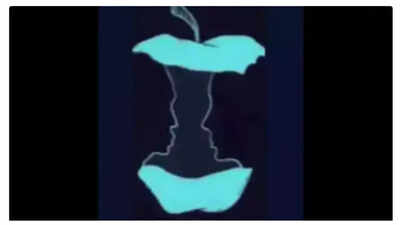Optical illusions are more than just fun brain teasers; they offer a fascinating glimpse into how our minds work. These visual puzzles challenge our perception, revealing how our brains interpret and sometimes misinterpret the world around us. A popular illusion circulating online presents viewers with a choice: do you see an eaten apple or two faces? Your answer may uncover a hidden aspect of your personality.

Optical illusions occur because our brains attempt to make sense of the information our eyes provide. When this information is ambiguous or contradictory, our brains fill in the gaps, sometimes leading to perceptions that differ from reality. This particular illusion, shared by Marina Winberg, plays on this ambiguity.
Winberg's post suggests that the image is a "classic dual-illusion." What you notice first – the apple core or the two faces – supposedly reveals something fundamental about your mindset.
If You See Two Faces: According to Winberg, perceiving the two faces first indicates that you are a logical and analytical thinker with strong morals. You value stability, solve problems creatively, and think before you act. However, your curiosity can sometimes get the better of you.
If You See an Apple Core: Seeing the apple core first suggests that you are intuitive and emotionally aware. You possess a strong ability to read subtle cues and know the right thing to say, though you often remain quiet. You prioritize stability and protect what matters to you.
Optical illusions are categorized into three main types:
Literal Illusions: These occur when the brain combines elements of an image to create a perception that isn't actually present. The apple/faces illusion is a prime example.
Physiological Illusions: These are caused by overstimulation of the visual system, often due to excessive exposure to light, color, or movement. Afterimages are a common example.
Cognitive Illusions: These illusions rely on the brain's subconscious interpretation of information. The Müller-Lyer illusion, where lines appear to be different lengths due to the surrounding shapes, is a classic example.
Optical illusions continue to fascinate and challenge our understanding of perception. Whether you see an apple core or two faces in this image, remember that these visual puzzles offer valuable insights into the complex workings of the human brain.
Older articles
 Beyond the Blood Test: 5 Subtle Signals of Prediabetes You Shouldn't Ignore
Beyond the Blood Test: 5 Subtle Signals of Prediabetes You Shouldn't Ignore
 Najmul Hossain Resigns as Bangladesh Test Captain After Sri Lanka Defeat
Najmul Hossain Resigns as Bangladesh Test Captain After Sri Lanka Defeat
 Gambhir Defends India's Tailenders Despite Costly Batting Collapses in England Test Loss
Gambhir Defends India's Tailenders Despite Costly Batting Collapses in England Test Loss
 Jannat Zubair Reveals "Biggest Regret" After "The Traitors" Elimination; Finale Looms
Jannat Zubair Reveals "Biggest Regret" After "The Traitors" Elimination; Finale Looms
 Wimbledon's All-White Dress Code: The History, Controversies, and Evolving Rules
Wimbledon's All-White Dress Code: The History, Controversies, and Evolving Rules
 Black Caps Prepare for Blockbuster Home Series Against Cricket Powerhouses
Black Caps Prepare for Blockbuster Home Series Against Cricket Powerhouses
 Facial Icing: Hype or Help? Weighing the Benefits, Risks, and Techniques of This Viral Beauty Trend
Facial Icing: Hype or Help? Weighing the Benefits, Risks, and Techniques of This Viral Beauty Trend
 Unexpected Downpour? Expert Tips for Quickly Drying Clothes While Wearing Them
Unexpected Downpour? Expert Tips for Quickly Drying Clothes While Wearing Them
 West Indies Coach Daren Sammy Fined, Receives Demerit Point for Umpire Criticism
West Indies Coach Daren Sammy Fined, Receives Demerit Point for Umpire Criticism
 Engineer Slams ECB's Pataudi Trophy Decision, Cites Disappointment Over Renaming
Engineer Slams ECB's Pataudi Trophy Decision, Cites Disappointment Over Renaming